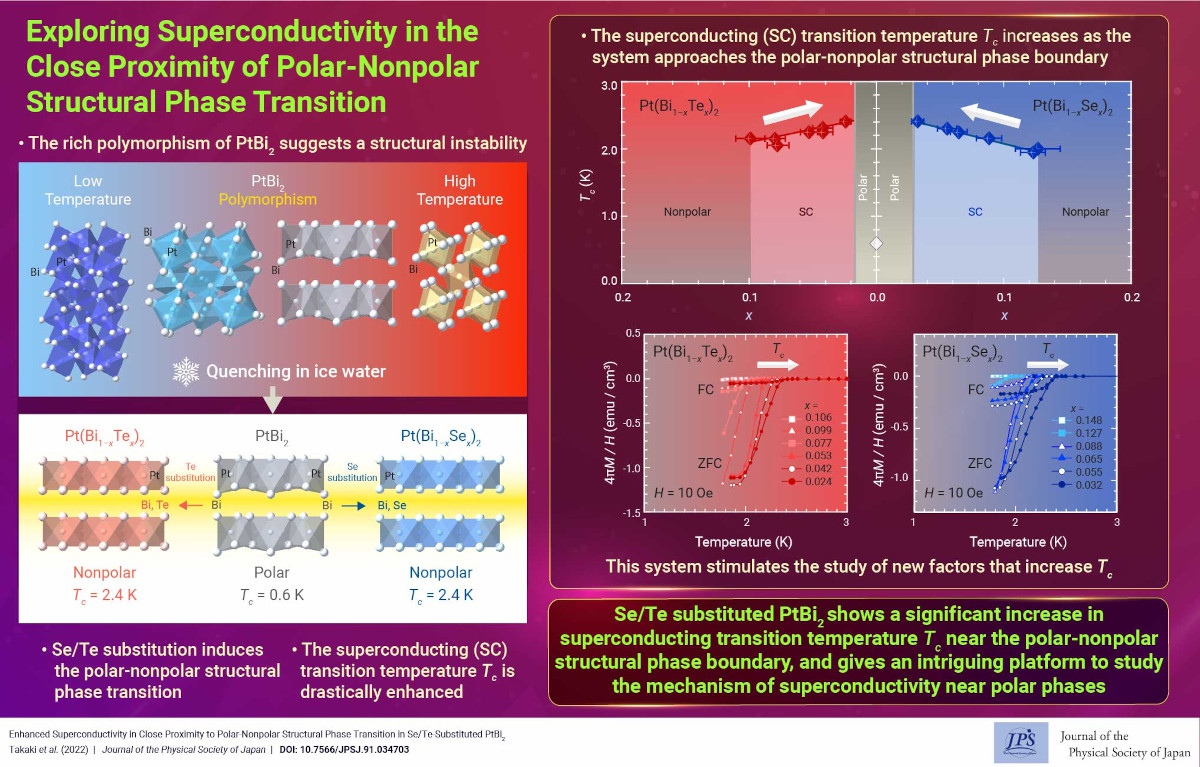Exploring Superconductivity in the Close Proximity of Polar-Nonpolar Structural Phase Transition
© The Physical Society of Japan
This article is on
Enhanced Superconductivity in Close Proximity to Polar-Nonpolar Structural Phase Transition in Se/Te-Substituted PtBi2
(JPSJ Editors' Choice)
J. Phys. Soc. Jpn.
91,
034703
(2022)
.
A polar-nonpolar structural phase transition and corresponding increase in superconducting transition temperature Tc are observed in chemically doped PtBi2. Tc increases as the system approaches the phase boundary.

Depending on the way in which the elements in the periodic table are combined, the compounds represented by MX2 (M = transition metal and X = pnictogen or chalcogen) exhibit a wide variety of crystal structures. This is because the structure changes depending on the energies and band filling of the d and p states. In this respect, the combination of Pt and Bi is quite exquisite, and thus PtBi2 alone exhibits various crystal structures such as α-PtBi2 (Pbca,  , No. 61), β-PtBi2 (
, No. 61), β-PtBi2 ( ,
,  , No. 205), γ-PtBi2(
, No. 205), γ-PtBi2( ,
,  , No. 147), γ'-PtBi2(P31m,
, No. 147), γ'-PtBi2(P31m,  , No. 157), and δ-PtBi2 (Pnnm,
, No. 157), and δ-PtBi2 (Pnnm,  , No. 58). This is a remarkable feature because PtP2, PtAs2, and PtSb2that are composed of elements of the same groups, in contrast, crystallize only in the same structure as β-PtBi2, suggesting the structural instability of PtBi2.
, No. 58). This is a remarkable feature because PtP2, PtAs2, and PtSb2that are composed of elements of the same groups, in contrast, crystallize only in the same structure as β-PtBi2, suggesting the structural instability of PtBi2.
In this study, the structural instability of PtBi2 has been utilized to explore structural phase transitions by chemical substitutions and the associated emergence of new physical properties. Notably, substituting Se or Te for some of the Bi in γ'-PtBi2 (P31m,  , No. 157) with a polar structure stabilizes the nonpolar structure (
, No. 157) with a polar structure stabilizes the nonpolar structure ( ,
,  , No. 164). This structural phase transition drastically increases superconducting transition temperature Tc from 0.6 K to 2.4 K. Tcincreases as the system approaches the polar-nonpolar structural phase boundary.
, No. 164). This structural phase transition drastically increases superconducting transition temperature Tc from 0.6 K to 2.4 K. Tcincreases as the system approaches the polar-nonpolar structural phase boundary.
According to the Bardeen-Cooper-Schrieffer (BCS) theory, when phonons soften in close proximity to a structural phase transition, Tcincreases. Indeed, such compounds have been noted. However, in close proximity to a polar-nonpolar structural phase transition, the polar structural instability is crucial. The effect of this on superconductivity remains unclear, and studies to explore superconductivity beyond the BCS theory are currently being actively conducted. The present study reports new compounds in which Tcis enhanced in close proximity to the polar-nonpolar structural phase transition. The systems can provide a unique opportunity to study the relationship between polar-nonpolar structural phase transitions and superconductivity from the viewpoints of the competition between the spin splitting of the Fermi surface and the superconducting gap and the soft-phonons related to the polar structural instability. The results of this study are expected to lead to new guidelines for the future understanding of superconductivity and the efforts to search for new fluctuations to increase Tc.
(written by Kazutaka Kudo on behalf of all authors.)
Enhanced Superconductivity in Close Proximity to Polar-Nonpolar Structural Phase Transition in Se/Te-Substituted PtBi2
(JPSJ Editors' Choice)
J. Phys. Soc. Jpn.
91,
034703
(2022)
.
Share this topic
Fields
Related Articles
-
Fractional Vortex Array with Nontrivial Topological Structure Realized at Twin Boundary of Nematic Superconductor
Superconductivity
2025-3-24
Analysis of the two-component Ginzburg-Landau theory suggests that a conventional vortex is transformed into two fractional vortices with the topological nature of core-down and core-up merons at the twin boundary of a nematic superconductor.
-
Exploring the Vibrant Interplay of Machine Learning and Physics
Cross-disciplinary physics and related areas of science and technology
Electron states in condensed matter
Elementary particles, fields, and strings
Mathematical methods, classical and quantum physics, relativity, gravitation, numerical simulation, computational modeling
Statistical physics and thermodynamics
Superconductivity
2025-3-13
This Journal of the Physical Society of Japan Special Topics edition explores how physics and machine learning complement each other and can solve unresolved problems in physics.
-
Single-Crystal Growth of a Cuprate Superconductor with the Highest Critical Temperature
Superconductivity
2024-5-20
Millimeter-sized single crystals of a trilayer cuprate superconductor (Hg,Re)Ba2Ca2Cu3O8+δ that exhibits the highest superconducting transition temperature under ambient pressure, were grown reproducibly and safely.
-
The Mysterious Superconductivity of Sr2RuO4
Superconductivity
2024-8-22
Researchers review the recent advancements made towards solving the mysteries of the unconventional superconductivity of Sr2RuO4, analyzing recent experiments and theoretical models and proposing approaches to resolve current challenges.
-
Discovery of Unconventional Pressure-Induced Superconductivity in CrAs
Electronic transport in condensed matter
Superconductivity
2024-8-13
A new study has discovered pressure-induced superconductivity in the helimagnet CrAs, originating in the vicinity of the helimagnetic ordering, representing the first example of superconductivity in Cr-based magnetic systems.




